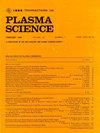基于波导的等离子体源中微波放电建模的二维轴对称简化的有效性
IF 1.3
4区 物理与天体物理
Q3 PHYSICS, FLUIDS & PLASMAS
引用次数: 0
摘要
基于波导的等离子体源中的微波放电建模是一个复杂的多物理场问题,涉及电磁、热和等离子体动力学的错综复杂的相互作用,对计算要求极高。以往的研究往往忽略矩形波导,只关注圆柱形放电管,并通过假设放电管中微波和等离子体分布的轴对称性,将其进一步简化为二维 2-D。然而,这一假设和简化的有效性仍然存在争议。为了解决这个问题,本研究比较了三维模型和二维轴对称简化模型的放电特性,以确定简化方法在哪些条件下是合适的,并澄清其局限性。结果表明,在某些条件下,二维轴对称模型可以有效捕捉三维放电行为的主要特征,从而大大节省计算成本。然而,当维持放电的微波电场打破轴对称时,偏差就会变得很大。这在厚度较小的玻璃管或允许非轴对称电磁模式的高导率管壁中表现明显。此外,本研究还介绍了一种利用相干波激励在基于双端口波导的等离子体源的放电管中执行微波场和等离子体分布轴对称的方法。本研究的结果可作为使用二维轴对称模型研究和设计其他微波等离子体源(MPS)的宝贵参考。本文章由计算机程序翻译,如有差异,请以英文原文为准。
Validity of 2-D Axisymmetric Simplification in Modeling Microwave Discharges in Waveguide-Based Plasma Sources
Modeling microwave discharges in waveguide-based plasma sources is a complex multiphysics problem involving the intricate interplay of electromagnetic, thermal, and plasma dynamics, which is extremely computational demanding. Previous studies often neglected the rectangular waveguide, focused only on the cylindrical discharge tube, and simplified it further into two-dimensions 2-D by assuming axisymmetry for the microwave and plasma distributions in the discharge tube. However, the validity of the assumption and the simplification remains controversial. To address this issue, this study compares the discharge characteristics between 3-D models and their 2-D axisymmetric simplifications to identify the conditions under which the simplified approach is appropriate and to clarify its limitations. The results indicate that the 2-D axisymmetric models can capture the main features of the 3-D discharge behavior effectively under certain conditions, offering significant computational cost savings. However, deviations become significant when the microwave electric field that sustains discharge breaks axial symmetry. This is evident in glass tubes with either a small thickness or high-permittivity walls that permit the nonaxisymmetric electromagnetic modes. Furthermore, this study introduces a method to enforce axisymmetry in the microwave field and plasma distributions in the discharge tube of a two-port waveguide-based plasma source using coherent wave excitations. The findings of this study can serve as a valuable reference in using the 2-D axisymmetric model to investigate and design other microwave plasma sources (MPSs).
求助全文
通过发布文献求助,成功后即可免费获取论文全文。
去求助
来源期刊

IEEE Transactions on Plasma Science
物理-物理:流体与等离子体
CiteScore
3.00
自引率
20.00%
发文量
538
审稿时长
3.8 months
期刊介绍:
The scope covers all aspects of the theory and application of plasma science. It includes the following areas: magnetohydrodynamics; thermionics and plasma diodes; basic plasma phenomena; gaseous electronics; microwave/plasma interaction; electron, ion, and plasma sources; space plasmas; intense electron and ion beams; laser-plasma interactions; plasma diagnostics; plasma chemistry and processing; solid-state plasmas; plasma heating; plasma for controlled fusion research; high energy density plasmas; industrial/commercial applications of plasma physics; plasma waves and instabilities; and high power microwave and submillimeter wave generation.
 求助内容:
求助内容: 应助结果提醒方式:
应助结果提醒方式:


